
 |
||
| Sapphire : a name derived from the Greek sappheiros. | ||||||||||||||
|
The name of sapphire comes from the Greek sappheiros, which means "dark
blue." Despite its name expressing only one out of its numerous colors,
the color palette of the sapphire includes: blue-purple, green, yellow,
clear, orange and pink-orange. Sapphire rings have been popular since the middle ages. Clergy favored blue sapphire rings because the color represented heaven. Magicians felt sapphire rings helped them command spirits. Many others felt a sapphire ring helped ward off evil and sickness, including the plague. Sapphires rings and sapphire jewelry have continued to remain popular throughout history. The British have a long-running love affair with sapphires. Prince Charles gave a sapphire ring to Princess Diana for their engagement. Sapphires were often used for decorating crowns the dark-blue sapphire of the "Saint Edward" is in the center of the cross of the British Empire Crown, and the Crown of the Russian Empire is decorated with two big sapphires (258 and 200 carats). Sapphires also adorn the cross on the Imperial Crown. The Star of India is perhaps the largest cut Star Sapphire weighing 536 carats. Among the most famous sapphires are two of the world largest. The Smithsonian Institute in Washington, D.C., houses the Logan Sapphire, a 423-carat cushion-cut stone from Sri Lanka that is set in a brooch surrounded by diamonds. |
||||||||||||||
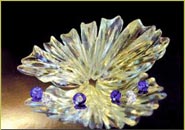 |
Citrine
& Sapphire
The second is the 258-carat bright blue sapphire from the Russian crown, kept in the Diamond Fund in Moscow. The Rockefeller Sapphire, weighing 62.02 carats, sold at auction in 2001 for US$3,031,000 ($48,871/carat) resulting in per carat and total pnbe Maria1 rexxrra1 for a single blue sapphire. The sapphire is considered the symbol of power, obedience, fidelity, chastity, and in the medieval times, it was called the "Stone of Bishop" and believed to be a stone of higher spiritual values. |
|||||||||||||
Apart from that, sapphire was believed to be capable of alleviating pain, averting conflicts, and giving eternal life to its owners. Sapphire was once believed to provide healing properties for colic, rheumatism and mental illness. It was also considered an antidepressant. The astrologers advise to wear sapphires to people born under the signs of Capricorn, Sagittarius and Aquarius. Sapphire is the birthstone for September and the zodiac sign Taurus; 5th, 23rd, and 45th wedding anniversary stone. Star Sapphire is given for 65th wedding anniversaries. Sapphire is a variety of the mineral corundum, AI2O3. The presence of iron and titanium causes the blue colour. Sapphire has a hardness of 9 and excellent toughness, making it a very good gemstone for all types of jewelry. Corundum comes in all colours of the spectrum - - the red form is known as ruby, the blue form is sapphire, and all other colours are known as fancy sapphire (and are described by their colour, i.e. pink sapphire or green sapphire). |
||||||||||||||
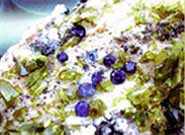 |
Sapphire
on Sphene
The most valuable sapphires are: velvety, slightly violet blue highly saturated in medium-to-medium dark tone, with 'sleepy' transparency. Historically the best sapphires come from Kashmir, so Kashmir sapphires are an equivalent to Colombian emeralds in terms of reputation of colour. |
|||||||||||||
Although more than two-dozen locales produce Appearance sapphires, the three most famous regions are Kashmir, Sapphires are found in a variety of colors. The Burma, ancf sri La'nKaT I he most"renowned is Kas'Rmir, a beautiful place high up in the Himalayas. Kashmir produces "cornflower" blue sapphires. Cornflower is an intense, medium-dark blue with a velvety appearance. Burmese sapphires are also lovely, but the blue is darker than those from Sri Lanka. Sri Lanka produces a sapphire that is lighter and brighter. Such sapphires are called Ceylon sapphires [Sri Lanka was formerly known as Ceylon. Nevertheless, whatever the color blue, and which ever is your personal favorite, sapphires have been worn and loved for centuries. |
||||||||||||||
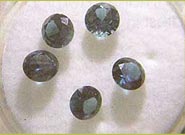 |
Sapphire
brilliant premium round The major sources for sapphires are: Australia, Thailand, Sri Lanka, Burma, also India, Kampuchea, Kenya, Tanzania and United States. |
|||||||||||||
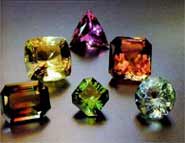 |
Appearance Sapphires are found in a variety of color. The reddish colors are called ruby. People generally think of sapphires as blue in color, although they are also colorless, pink, orange, green, golden, yellow, purple and black. Sapphire is the birthstone of the month of September. Red sapphires are known as ruby and pinkish orange sapphire as padparadscha. Enhancements Sapphire is often heat treated to produce, intensify or lighten color and / or improves color uniformity and appearance. Heat treatment of sapphires is performed at the sapphires is performed at the sapphire mines, and is an industry-wide accepted practice. |
|||||||||||||
| Germany's Premier Gem Show to reveal latest in region's lapidary art & jewelry design | ||||||||||||||
Some 90 miles south of Frankfurt, is a gem cutting and trading center with a long and illustrious history. The region around this picturesque and quaint German twin-city is home to more than 500 businesses in the gem and jewelry trade. The city itself is all about gemstones — known for the past 500 years as the place to find top quality, superior craftsmanship, and the unique and unusual in color—the focus of the Intergem trade fair held there every October going on 21 years, Sept. 30 to Oct. 3, 2005. |
||||||||||||||
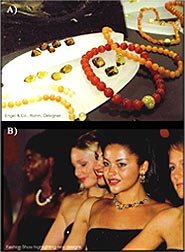 |
A) Engel & Co. Rohm, Designer
B) Fashion show highlighting
new designs An intimate, salon-type show, Intergem features 130 of the region's leading companies in lapidary arts and trendsetting design. The exhibitors represent a diverse cross section of work from carvings, cameos, engravings and beads to cultured pearls, fancy color diamonds, gem-set jewelry, and equipment. In this highly competitive retail environment with slipping profits in the industry's bread and butter, white diamonds, jewelers are looking to color to bolster sales and margins. Perhaps the gem trade's best kept secret, Intergem is positioned as a unique shopping venue specializing in distinctive color — a must-go for any jeweler who is or wants to be involved in gemstones. A great example of what makes this area so special is in the works of Manfred Wild of Emil Becker, Kirschweiler. A 42-year veteran, Wild creates fantasy out of precious gems and metals. Every Intergem he unveils an object fit for a king, and priced comparatively to "a nice villa" as he likes to describe. Last year it was an elaborate Buddha weighing more than 50 pounds in gemstones and 18k gold. The year before that it was a vase carved from a 150-pound citrine filled with a bouquet of gem flowers. Wild's whimsical collection includes wildlife, plants, musical instruments, and candy and cookies in petrified palm wood and jasper that would fool the most discerning sweet tooth. |
|||||||||||||
Among the leading lapidary artists also exhibiting at the show are Hans Ulrich Pauly, Dieter Lorenz, and Tom Munsteiner. Exciting new launches at the fair include Pauly's debut of a collection of carved gemstone cufflinks called Stone Buttons, which can stand alone or be embellished by a goldsmith, in striped and drusy agate, petrified palm wood, lapis, picture jasper, and blue chalcedony. To recognize the 20th anniversary of his company, Pauly: The Art of Carving is hosting studio tours for attending journalists to learn more about the artist and his craft |
||||||||||||||
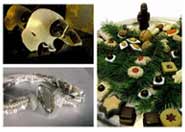 |
A) Emil Becker, Designer
B) Ulrike Weyrich, Designer C)
Kirschweiler, Designer There are many companies representing a broad range of gem products as well, including Constantin Wild, Groh & Ripp, Hermann Grimm, and Wild & Petsch. Moreover, there are firms specializing in specific material like Ekkehard Schneider, who is known for his wide selection of mandarin garnet; Rolf Goerlitz focuses on exotic gems like alexandrite and demantoid; Hermann Lind II is dedicated to garnets; and Emil Weis Opals and Opal Country are all about opals. Trend-trackers hot for the latest in gem fashion also will find many choices in unique beads by such houses as Engel & Co., Rohm, Alfred Ruppenthal, and Ulrike Weyrich. |
|||||||||||||
Attendees also will benefit from lectures conducted during the fair by renowned industry experts in the field of gemology, gem cutting and carving, gem-set jewelry design, and the healing powers of gemstones. There will be a fashion show highlighting new designs by exhibiting companies; and visitors will enjoy a special performance of the musical, "The Magic of Gemstones," at the Stadtthteater of Idar-Oberstein. Since it debuted last winter, critics have given the production, written by local gem cutter Theo Biegel, a thumb's up. It is hailed as a multi-faceted play with elements of classical comedy and satire, as well as mysticism. Among the actors in the cast is lapidary artist Hans Ulrich Pauly. www.intergem.de |
||||||||||||||
| Emeralds : the ancient mine | ||||||||||||||
Emeralds have one of the longest histories of all gemstones. The word emerald derives from the Greek word "smaragdos". Tools found at the entrance to ancient emerald mines in Egypt date back to the Rameses II era, about 1300 B.C. When the Spanish invaded South America, the conquistadors observed the native rulers wearing them. In 1537 the Spanish discovered the famous Chivor and Muzo mines, in what is now Colombia. Because the rich green color of emerald is the color of spring, the ancients prized it as the gemstone symbolizing love and rebirth. Treasured for at least 4,000 years by different cultures all around the world, emerald is said to quicken the intelligence as well as the heart. Legend gives its owner the gift of eloquence. Ancient emeralds were from mines in Egypt and perhaps what is now Afghanistan. But Spaniards arriving on the continent of South America were stunned to see emeralds finer and larger than any ever seen before. The Spaniards spent years searching for the source of the fantastic green stones favored by the Incas. They found it finally in what is today Colombia. |
||||||||||||||
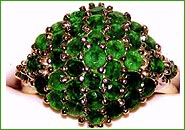 |
Emerald
Ring Hernando Cortes, the conquerer of Mexico, was carrying carved emeralds taken from the Aztecs in the shapes offish and flowers and a carved emerald bell, and an emerald the size of a man's palm when he was ship wrecked. Many of the finest stones were lost forever. The Incas had an emerald goddess, a fabulous emerald the size of an ostrich egg. In tribute they sacrificed her children: smaller emeralds which were presented to the goddess. Treasure hunters seeking wrecks of Spanish galleons are occasionally rewarded with the ultimate treasure: emeralds lost by the conquistadores long ago. Cleopatra prized her emeralds more than any other gem. She may have dropped her pearls in her wine for Mark Anthony but she kept her emeralds for herself! The ancient emerald mines of Cleopatra, long a mystery, were discovered again a hundred years ago near the Red Sea. Some tools found in the mine were dated at 1650 B.C. but no quality emeralds were found: the mines were exhausted thousands of years ago. Mummies in ancient Egypt were often buried with an emerald on their necks carved with the symbol for verdure, flourishing greenness, to symbolize eternal youth. Emeralds from what is now Colombia were part of the plunder when sixteenth-century Spanish explorers invaded the New World. The Indians had already been using emeralds in their jewelry and religious ceremonies for 500 years. The Spanish, who treasured gold and silver far more than gems, traded emeralds for precious metals. Their trades opened the eyes of European and Asian royalty to emerald's majesty. |
|||||||||||||
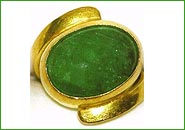 |
||||||||||||||
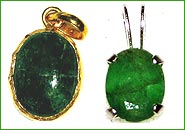 |
Emerald
Pendant Emerald is often mined and sold under peril - the natural resource Colombians cherish is also coveted by underworld drug traders. The availability of fine-quality emerald is limited, and emerald was plagued in the late 1990s by negative publicity about treatments commonly used to improve its clarity. The Romans also loved emeralds because, as ancient scholar Pliny said, "Nothing greens greener." Pliny said that emerald was the only gem that delighted the eye without fatiguing it. He said his eyes were restored when gazing at emerald. Emperor Nero wore emerald sunglasses to watch the gladiators. |
|||||||||||||
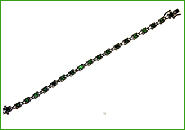 |
Emerald Bracelet One legend says that Satan lost the emerald from his crown when he fell. The emerald was shaped into a bowl that the Queen of Sheba sent to Nicodemus. Christ used the bowl at the last supper and Joseph of Arimathea used the bowl to catch blood from the cross, founding the order of the Holy Grail. The Moguls of India, including Shah Jahan,
the builder of the Taj Mahal, loved emeralds so much they inscribed
them with sacred text and wore them as talismans. Some of these sacred
stones, called Mogul emeralds, can still be seen in museums and collections
today. Emerald is the birthstone for May, the month of springtime romance, and the anniversary gemstone for the twentieth and thirty-fifth year of marriage. |
|||||||||||||
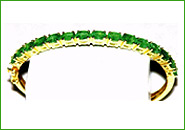 |
||||||||||||||
| Alessandra Lanna | ||||||||||||||
Aiessandra Lanna, born and raised in Rome, studies jewelry at the European Institute of Design, Rome, and attends specialistic courses at Domus Academy, Milan, and Central Saint Martins, London. During those years she obtains a working placement at Swarovsky in Innsbruck, Austria, and Uno Aerre in Arezzo, Italy. She is also awarded the World Gold Council "Best Designer of 2000". The same jewel is later presented at "Donna Sotto Le Stelle", the most prestigious Italian fashion event. : |
||||||||||||||
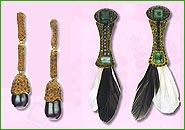 |
Tribal Dencers:
A Pair of earrings in black and yellow gold, black diamond a emerald
round cut, black & white feathers. Following her studies, Alessandra moved to New York City where she had the opportunity to work for the forecasting agency MPD studio design, and express her creativity, technical skills, and live in a multicultural city full of life and resources. Among her clients Uno Aerre and Gem.net. With the further knowledge and experience obtained in the USA she returned to Italy in order to design her own collection of jewelry. While applying her talents to this creative research, Alessandra continues her career as a freelance designer for Versace Jewelry. |
|||||||||||||
Alessandra defines her work, made of unique pieces in gold and precious stones, feminine yet strong. Currently she is based in Rome, designing and working closely with expert artisans - all jewelry pieces are manufactured entirely in Italy. She is often abroad researching and meeting private clients and buyers, going to exhibitions, events, auctions and fairs. She goes regularly to Paris, London, New York, Hong Kong, and Jaipur where she personally selects and buys precious stones for her collection. Once a year her work is exhibited at the Antique Show in Las Vegas. |
||||||||||||||
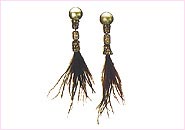 |
Princesses: A pair
of earrings in black gold, brown Tahiti pearls, round and rose cut brown
diamond, brown feathers. The most important aspect of her work is the research, experimentation, and study behind each piece. These are the things that most inspire and stimulate her to keep going. Alessandra considers her work an emotional and personal experience. |
|||||||||||||
| Shuan Leane: Jewellery designer of the year 2004 and 2005 | ||||||||||||||
 |
||||||||||||||
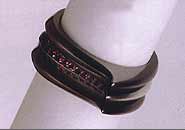 |
Shaun Leane is a London-based jewellery
designer. He trained by apprenticeship in Hatton Garden working with
traditional English jewellery. |
|||||||||||||
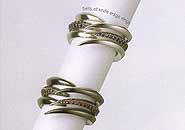 |
Over this thirteen-year period he was
immersed in the craft of goldsmithing, fashioning delicate antique pieces
and using precious metals and stones. He took a break from work to take
a formal course at Sir John Cass College in East London, where he studied
fine art and silver smithing. |
|||||||||||||
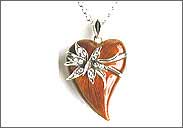 |
Later, he set up an independent practise
in London's Hatton Garden. In 1991 he began a valuable partnership with
Alexander McQueen, producing a number of pieces for McQueen's second catwalk
show 'Highland Rape'. As the extravagance and scale of McQueen's catwalk
presentations grew, so did the scale and elaboration of Lane's creations
- to a scale that could be described as full body sculpture.Leane draws
his inspiration from street culture, the club scene and urban life. |
|||||||||||||
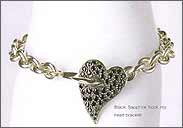 |
He aims to encompass values of strength,
confidence and beauty into his work and produce peces that don't just
function as accessories, but say something about the individual wearing
them. |
|||||||||||||
| |
||||||||||||||
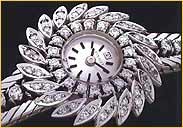 |
The exhibition
TIME-less jewellery: diamond watches by the Diamond Museum in Antwerp,
Belgium, passes by the manufacture of watches and the reference to precise
timetables. Instead THE ART of the watch is presented by showing 400 years
of WATCH ADORNMENT, thus giving a specific view on the ornamentation
of watches with DIAMONDS and other gem stones. 1 TISSOT, montre -watch "Fleur", 1960, white gold, mother-of-pearl, diamond.copyright: Diamantmuseum/Swatch Group Belgium N.V. Rare piece from he Tissot Collection, brought into production in 1960, containing 58 diamonds |
|||||||||||||
|
||||||||||||||
 |
||||||||||||||
| |
||||||||||||||
A legend in the fine timepiece and diamond industry, Jacob Arabo has become synonymous with celebrity glamour, customized design and signature flair in his diamond jewelry and watch collections. For the Basel 2005 Watch Fair, Jacob established himself as a force in fine watch making with the unveiling of his Five Time Zone Automatic time piece, a stunning model befitting Jacob's aesthetic sensibilities and growing technical pursuit of perfection. A first of its kind, this mechanism, which took eighteen months to develop, offers the five time zone function plus calendar date indicator. Offering endless diamond possibilities, Jacob redesigned the classic with a different thought in mind: the man in the three piece suit. |
||||||||||||||
|
||||||||||||||